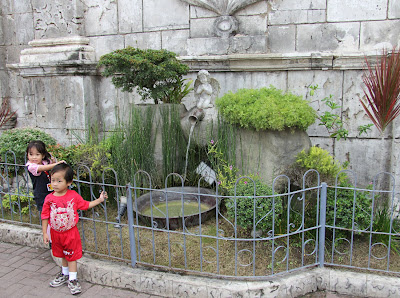Here, too, jeepneys are the common mode of transportation:
After a day at the beach we got soon bored again and invigorated by an early morning yoga class we decided to do some of the dreaded sight seeing again. Close to our resort was the place where Lapu-Lapu and his 1500 warriors fought off the Spanish invasion. Magellan was killed and Lapu-Lapu became a national hero. On Mactan that is, everywhere else they seem to be happy that they were invaded by the Spanish. Here you can see Lapu-Lapu holding a bolo knife (itàk) and a shield:
In 1866 this obelisk-ish monument was build in honour of Magellan inside the Lapu-Lapu shrine by the Augustinian priest Simon Aguirre:
This is the supposed spot where Magellan was killed by Lapu-Lapu. In the background is a panorama painting depicting the battle of Mactan.
Then we took a free ride to a shopping mall of a different kind ;) Just kidding, Philippine people tend to give weird names to their shops.
Magellan Cross was next. When Magellan arrived on the island of Cebu in 1521 he soon befriended himself with chief Rajah Humabon and -probably with the help of exquisite gifts- managed to get Rajah and his large family baptised. To celebrate this success he had a wooden cross erected. What one can see today is an outer-casing cross; the original is said to be inside this casing.
Just for a bit of atmosphere:
Close to Magellan's cross is the Basilica of Santo Niño, an Augustinian 16th century church basilica (Pope Paul VI elevated it's status from church to minor basilica in 1965). Here a relief carving on the outer wall:
Although a lot of children are playing outside the church, this was not the reason for its name.
Nor were the bats in the church responsible for it (albeit quite fun to watch them fly around in the church; that proves that vampires are not afraid of being in a church)
It got it's name from the 'Holy Child of Cebu' (Santo Niño de Cebú), a wooden figure of the Child Jesus which Magellan gave or gave not to Rajah's wife. In any case, the church was build on the spot where the burnt box with the child figure was found. Since it is said the Cebu Jesus wrought several wonders of which I couldn't find a single in the web this basilica is magnet for pious people. So of what nature could the miracle be? Maybe it was the trance like dance the natives started when the Spanish presented the figure? Nahhh... so although there is a complete absence of evidence for these miracles Philippine people are very devoted and pray for little miracles in their daily lives. They spit and wipe the glass that separates them from little Jesus, obviously not knowing that this is just a replica which couldn't fulfil even the most trifling and petty wish. The original is kept in the convent, predestined to work on larger miracles.












--that proves that vampires are not afraid of being in a church
ReplyDeletewrong! it proves they are not afraid of minor basilicas^^
sry. you had that coming
ReplyDeleteWell, as usual, physicists are a tiny bit more precise than archaeologists :)
ReplyDeleteThe jeepneys, almost look like toy cars.
ReplyDelete@Shaheen:
ReplyDeleteYes, Philippine people have a fondness for bright and playful colours :)